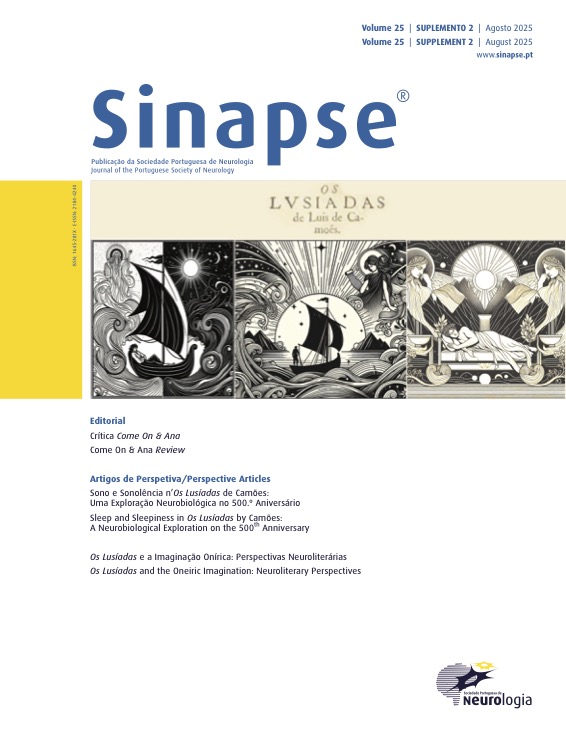Os Lusíadas and the Oneiric Imagination: Neuroliterary Perspectives
DOI:
https://doi.org/10.46531/sinapse/AP/178/2025Keywords:
Dreams, History, 16th Century, Literature, NeurosciencesAbstract
In the context of the fifth centenary of Luís de Camões, this article investigates the representation of dreams in Os Lusíadas through an interdisciplinary approach combining literature and neuroscience. A systematic survey of occurrences of the terms "dream" and "dreams" throughout the epic reveals how Camões transforms the oneiric imagination into a multifaceted narrative device. The analysis shows that dreams in Camões’ work are not merely stylistic devices but serve as structural elements that articulate three essential dimensions: the internal conflicts of characters, the heroic aspirations of the narrative, and the psychological anxieties inherent to the maritime journey. Vasco da Gama, the central protagonist, is profoundly influenced by oneiric experiences - both his own and those of other characters - which reflect his fears, desires, and quest for transcendence. By exploring these passages, the study identifies a complex dialogue between Renaissance conceptions of divine intervention and the legacy of classical epics. Furthermore, by engaging with contemporary neurobiology of dreams, it demonstrates how Camões’ oneiric descriptions can be interpreted in light of cognitive processes now mapped by science - such as visual vividness, associated with the occipital cortex, and emotional intensity, linked to amygdala activity during REM sleep. These connections, though interpretive, highlight a relationship between the work and current scientific advancements. This interdisciplinary perspective enriches our understanding of Os Lusíadas, showing how its representation of the oneiric universe remains relevant and engages with the latest investigations into the human mind.
Downloads
References
Camões L. Os Lusíadas [Internet]. Project Gutenberg; 2007 [citado 2025 abr 4]. Disponível em: https://www.gutenberg.org/ebooks/3333 Camões L.
Camões L. Os Lusíadas [Internet]. Ramos EP, editor. Porto: Porto Editora; 1972. Disponível em:https://archive.org/details/os-lusiadas-luis-de-camoes/page/106/mode/2up? q =sonhos
Ferro M. O sonho na épica quinhentista. Camões e Tasso em confronto. Imaginação e Literatura. Série “Leonardo” 5, 2009, 5: 53-83
Nir Y, Tononi G. Dreaming and the brain: from phenomenology to neurophysiology. Trends Cogn Sci. 2010;14(2):88-100.
Hobson JA, Pace-Schott EF. The cognitive neuroscience of sleep: neuronal systems, consciousness and learning. Nat Rev Neurosci. 2002 Sep;3(9):679-93.
Mutz J, Javadi AH. Exploring the neural correlates of dream phenomenology and altered states of consciousness during sleep. Neurosci Conscious. 2017;2017(1):nix009.
Sterpenich V, Perogamvros L, Tononi G, Schwartz S. Fear in dreams and in wakefulness: Evidence for day/night affective homeostasis. Hum Brain Mapp. 2020;41(3):840-850.
Raichle ME. The brain's default mode network. Annu Rev Neurosci. 2015 Jul 8;38:433-47. doi: 10.1146/annurev-neuro-071013-014030.
Ramon M. Sonho de Dom Manuel, em Os Lusíadas edição de 1636 por Manuel Faria e Sousa, Edição Fac similada. INCM, 1972. https://repositorium.sdum.uminho.pt/ bitstream/1822/61301/1/ Sonho%20de%20D.%20Manuel%20final.pdf
Simor P, Peigneux P, Bódizs R. Sleep and dreaming in the light of reactive and predictive homeostasis. Neurosci Biobehav Rev. 2023;147:105104.
Downloads
Published
How to Cite
Issue
Section
License
Copyright (c) 2025 Marleide de Mota Gomes, António Martins da Silva

This work is licensed under a Creative Commons Attribution-NonCommercial 4.0 International License.








